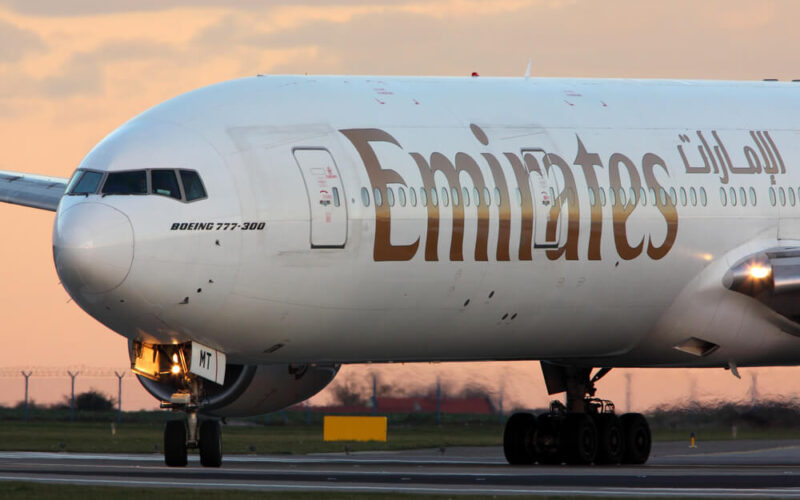A new study, published by the Centers for Disease Control and Prevention (CDC) and conducted by several New Zealander authors, has revealed how transmission of COVID-19 occurred on an Emirates flight to Auckland, New Zealand, despite pre-departure testing.
The study, conducted by several New Zealander authors, including Dr. Tara Swadi who is the chief advisor about COVID-19 at the Ministry of Health New Zealand, revealed how Emirates flight EK448 from Dubai, the United Arab Emirates, to Auckland, New Zealand, via Kuala Lumpur, Malaysia, brought back seven positive COVID-19 cases, despite passengers required to test prior to their departures.
The flight, which landed in New Zealand on September 29, 2020, was operated by an Emirates Boeing 777-300ER. In total, 86 passengers were on board the flight, including the seven passengers who later tested positive. The seven were traveling to Auckland, New Zealand, via Dubai, originating from five different countries: Ireland, India, Ukraine, South Africa, and Switzerland. While all seven entered managed isolation and quarantine (MIQ) upon their arrival in the Pacific island, they tested positive for COVID-19 in the MIQ. Three passengers returned a positive Polymerase chain reaction (PCR) test on October 2, 2020, while the remaining four showed the infectious disease between October 6 and October 8.
Questionable pre-departure testing
“During the flight and before departure in Dubai airport, mask use was not mandatory; passengers A, B, D, F, and G self-reported mask and glove use while on the airplane but passengers C and E did not,” noted the authors.
It is assumed that the person to bring COVID-19 onboard the aircraft was Passenger A, who traveled from Switzerland, according to the study. The passenger, together with their travel buddy Passenger B both tested negative before September 25, 2020.
All seven passengers were seated between rows 24 and 28, while Passengers F and G from South Africa traveled with a four-person group, interchanging seats in the middle of row 24. Two out of the four returned positive results. However, F and G lived in the same room in the MIQ facility, Passenger G’s infection was “not considered a result of in-flight transmission.”
In total, between the four rows, there were 15 passengers, including the seven studied cases. The study assumed a five-day incubation period, except for Passenger C, who was given a three-day incubation period. The median presymptomatic infectious period was between one and four days unless a negative test result proved otherwise.
The suspicion that the passengers might have been infected onboard the flight was “strongly supported by the epidemiologic data, in-flight seating plan, symptom onset dates, and genomic data.” The possible infection also presents a “likely scenario of >4 SARS-CoV-2 transmission events,” highlighted the study, on the Emirates itinerary.
“Although not definitive, these findings underscore the value of considering all international passengers arriving in New Zealand as being potentially infected with SARS-CoV-2, even if pre-departure testing was undertaken, social distancing and spacing were followed, and personal protective equipment was used in-flight,” concluded the authors.
The study, including four other articles that were published by the CDC, showcase the potential of COVID-19 spread during a flight. The International Air Transport Association (IATA) has called for the reopening of borders and replacing quarantine measures with mandatory testing.
“With the potential to safely re-open borders and revive travel with testing, governments will need to add measures that stimulate demand,” stated IATA’s chief executive Alexandre de Juniac on December 8, 2020, requesting help to bring back the demand for air travel.
Many airlines, including Emirates, have boasted about the safe environment onboard aircraft throughout 2020. The HEPA filters, which according to the CDC “provide efficiencies greater than 99.9999%” against particulates in the 1- to the 10-µm range, are present on most commercial aircraft, including the Boeing 777-300ER.
HEPA filters help “provide a safer, healthier and more comfortable environment for the passengers and crew,” read a statement by Emirates in March 2020. Furthermore, the airline has dubbed itself the “safest airline in its response to the COVID-19 pandemic,” as its “industry-leading safety standards” have allowed it to ensure the health of its passengers.
Fly better with Emirates, the world’s safest airline in its response to the COVID-19 pandemic as per the Safe Travel Barometer. https://t.co/556IT8342w #FlyEmiratesFlyBetter @safetraveltech pic.twitter.com/N3bMDmaJJZ
— Emirates Airline (@emirates) November 16, 2020

